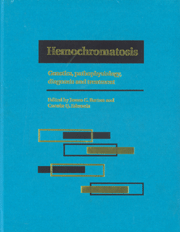Book contents
- Frontmatter
- Contents
- List of contributors
- Foreword
- Part I Introduction to hemochromatosis
- Part II Genetics of hemochromatosis
- Part III Metal absorption and metabolism in hemochromatosis
- Part IV Diagnostic techniques for iron overload
- Part V Complications of iron overload
- Part VI Therapy of hemochromatosis and iron overload
- Part VII Infections and immunity in hemochromatosis
- Part VIII Hemochromatosis heterozygotes
- 39 The iron phenotype of hemochromatosis heterozygotes
- 40 Ascertainment of hemochromatosis heterozygosity
- 41 Disease risk in hereditary hemochromatosis heterozygotes
- Part IX Relationship of hemochromatosis to other disorders
- Part X Animal models of hemochromatosis and iron overload
- Part XI Screening for hemochromatosis
- Part XII Hemochromatosis: societal and ethical issues
- Part XIII Final issues
- Index
39 - The iron phenotype of hemochromatosis heterozygotes
from Part VIII - Hemochromatosis heterozygotes
Published online by Cambridge University Press: 05 August 2011
- Frontmatter
- Contents
- List of contributors
- Foreword
- Part I Introduction to hemochromatosis
- Part II Genetics of hemochromatosis
- Part III Metal absorption and metabolism in hemochromatosis
- Part IV Diagnostic techniques for iron overload
- Part V Complications of iron overload
- Part VI Therapy of hemochromatosis and iron overload
- Part VII Infections and immunity in hemochromatosis
- Part VIII Hemochromatosis heterozygotes
- 39 The iron phenotype of hemochromatosis heterozygotes
- 40 Ascertainment of hemochromatosis heterozygosity
- 41 Disease risk in hereditary hemochromatosis heterozygotes
- Part IX Relationship of hemochromatosis to other disorders
- Part X Animal models of hemochromatosis and iron overload
- Part XI Screening for hemochromatosis
- Part XII Hemochromatosis: societal and ethical issues
- Part XIII Final issues
- Index
Summary
Introduction
The issue whether hemochromatosis heterozygotes develop disease-related morbidity is controversial. Because iron is the source of the organ damage in hemochromatosis, heterozygotes would have to become iron loaded for complications to occur. By definition, heterozygotes have one-half of the hemochromatosis genotype, possessing one mutant and one wild-type allele. Does the presence of one-half of the hemochromatosis gene product result in the expression of one-half of the homozygous phenotype? Most importantly, do hemochromatosis heterozygotes develop disease-related morbidity?
Even if heterozygotes do not develop an intermediate hemochromatosis phenotype, they may be at increased risk of morbidity if other disorders, such as porphyria cutanea tarda, hereditary spherocytosis, or beta-thalassemia minor are present. Does excess iron in hemochromatosis heterozygotes confer upon them an increased risk to develop cancer or coronary artery disease? Answers to some of these intriguing questions will be considered in the current chapter and will be considered in additional detail in other chapters of this book.
Identification of heterozygotes
Hemochromatosis is tightly linked to the HLA Class I region on chromosome 6. It is therefore possible to assign a hemochromatosis genotype within a pedigree based on HLA-A serotypes shared with the proband. Due to autosomal recessive transmission of hemochromatosis, parents and offspring of a proband are, at least, obligate heterozygotes. This chapter describes the iron phenotype of members of pedigrees who have been assigned the heterozygous genotype based on half-HLA-identity with a homozygous proband.
- Type
- Chapter
- Information
- HemochromatosisGenetics, Pathophysiology, Diagnosis and Treatment, pp. 411 - 418Publisher: Cambridge University PressPrint publication year: 2000
- 5
- Cited by



